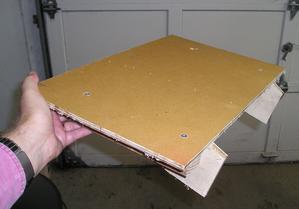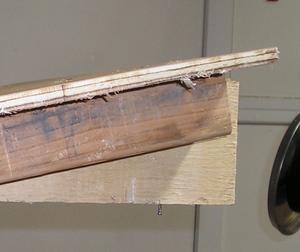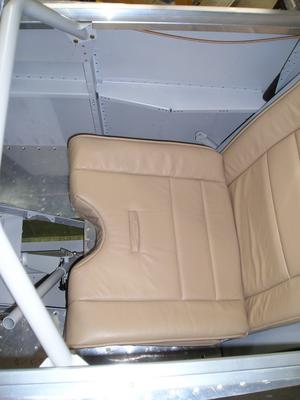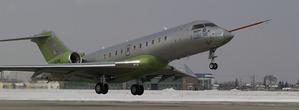Dynon EFIS AOA and OAT news
- Details
- Written by Kevin Horton
- Hits: 3614
I received an e-mail from Dynon Avionics yesterday with news on new features for their D-10 EFIS. They are now shipping unheated Angle of Attack/Pitot probes, and they plan to add Outside Air Temperature sensors later. OAT support will allow the EFIS to calculate True Airspeed.
Subject: FW: DYNON AVIONICS NOW DELIVERING COMPLETE EFIS-D10 SYSTEM
Date: Fri, 10 Oct 2003 14:49:49 -0700
We would like to take this opportunity to update all of you on our emaillist as to the latest from Dynon Avionics. As of this writing, we haveshipped over 450 EFIS-D10s. We are very pleased with the market acceptanceof our product and look forward to serving all of our current and futurecustomers with the best customer service we can provide.
The latest developments include the release of the unheated version of theDynon AOA/Pitot probe and the release of V1.05 software to support it. TheAOA/Pitot probe completes the original vision for the EFIS-D10 and gives thepilot complete flight information in a highly usable format all on onecompact display. We are continuing to work on both the heated version ofthe AOA/Pitot probe and the OAT (outside air temperature) sensor andsupporting software. Pricing for the OAT sensor has not been set at thistime but will continue the Dynon tradition of outstanding performance at avery affordable price. The OAT sensor will require the external compassmodule (EDC-D10) that contains the hardware interface and the signalconditioning needed for the sensor. With the OAT sensor, the EFIS-D10 willadd an INFO type display of OAT, TAS (true airspeed), and DA (densityaltitude). We hope to have both the heated AOA/Pitot probe and the OAToption available late this year.
On the manufacturing side, we have caught up with almost all back orders andwill generally be able to ship an EFIS-D10 within two weeks of receivingyour order. If you have held off purchasing a unit because of the wait, nowis the time to place your order! Pricing remains the same and is asfollows:
EFIS-D10 Electronic Flight Information System $1995
EDC-D10 Electronic Digital Compass $99
Internal backup battery $129
Unheated AOA/Pitot probe $199
Flush Mount Bracket $20
We continue to monitor various email lists as well as email sent directly tous. We are very pleased with the flight reports on these lists and willcontinue to make improvements in the product as we are made aware of anyissues with the EFIS. If you havenât had a chance to see the EFIS inperson, we will be sharing a booth with Aerotronics at Copperstate. Stop byand take a look and weâll answer any questions you might have. Weâve alsorecently updated our web site with a revised FAQ, new pictures of the EFISdisplays and dimensions of the AOA/pitot probe (www.dynonavionics.com).
As always, we're happy to answer questions either via telephone at425-402-0433 or email at This email address is being protected from spambots. You need JavaScript enabled to view it..
The crew at Dynon Avionics.
Rear Seat Riser Test
- Details
- Written by Kevin Horton
- Hits: 6302
Progress is frustrating slow. Too many other things going on. Last Sunday I spent most of the day with Terry as we haven't had much time together lately. We had company here from Monday until Thursday, so I didn't get much done then either.
 Today I made a trial rear seat riser out of scrap plywood from one of the kit shipping crates. I'm not sure who first came up with the rear seat riser idea, but Cleaveland Tools created the plans that I am using (full size plans). The RV-4 and RV-8 rear seat cushions sit right on the floor. The RV-8 does have sunken foot wells for the rear seater to put his feet in, which helps a bit, but the basic seating position does have the butt fairly low. The rear seat riser is a platform that lifts the rear seat cushion about three inches off the floor at the front, and slants back to be about 1.25 inches high at the rear. I wasn't sure those dimensions would be ideal for my aircraft, so I decided to make one out of wood to test out the dimensions before making the real one from aluminum sheet.
Today I made a trial rear seat riser out of scrap plywood from one of the kit shipping crates. I'm not sure who first came up with the rear seat riser idea, but Cleaveland Tools created the plans that I am using (full size plans). The RV-4 and RV-8 rear seat cushions sit right on the floor. The RV-8 does have sunken foot wells for the rear seater to put his feet in, which helps a bit, but the basic seating position does have the butt fairly low. The rear seat riser is a platform that lifts the rear seat cushion about three inches off the floor at the front, and slants back to be about 1.25 inches high at the rear. I wasn't sure those dimensions would be ideal for my aircraft, so I decided to make one out of wood to test out the dimensions before making the real one from aluminum sheet.
 I placed the two vertical plywood supports so they would sit on top of the seat ribs that support the floor. I didn't want those plywood pieces to end up a bit off the seat ribs if the riser slide sideways, as that would force all the weight to be supported by the thin aluminum floor. So, I put a short nail in the bottom of each plywood rib so that it would fit into an empty screw hole on the seat ribs and prevent the plywood from moving.
I placed the two vertical plywood supports so they would sit on top of the seat ribs that support the floor. I didn't want those plywood pieces to end up a bit off the seat ribs if the riser slide sideways, as that would force all the weight to be supported by the thin aluminum floor. So, I put a short nail in the bottom of each plywood rib so that it would fit into an empty screw hole on the seat ribs and prevent the plywood from moving.
 I put the seat cushions in place on the rear seat riser, climbed in and pulled the canopy closed. I found that my head was a bit too close to the canopy, so I pulled the one inch booster cushion off the bottom of the rear seat cushion and tried again. That seemed to work reasonably well, but I'm not a big guy. I'll get my coworker Jim over to try it out. I suspect I may have to lower the top of the seat riser a bit to better fit tall passengers. The RV-8 canopies are free-blown, rather than being made in a mold. So every canopy is a slightly different shape, which affects the amount of head room in the rear seat. My canopy may be slightly lower than average, which would also change the angle that it sits on the frame. This would be consistent with the fit problems I had on the canopy skirt.
I put the seat cushions in place on the rear seat riser, climbed in and pulled the canopy closed. I found that my head was a bit too close to the canopy, so I pulled the one inch booster cushion off the bottom of the rear seat cushion and tried again. That seemed to work reasonably well, but I'm not a big guy. I'll get my coworker Jim over to try it out. I suspect I may have to lower the top of the seat riser a bit to better fit tall passengers. The RV-8 canopies are free-blown, rather than being made in a mold. So every canopy is a slightly different shape, which affects the amount of head room in the rear seat. My canopy may be slightly lower than average, which would also change the angle that it sits on the frame. This would be consistent with the fit problems I had on the canopy skirt.
There is a cutout in the rear seat bottom cushion to make room for the movement of the control stick. I get the impression that the stick might rub against the seat cushion if the stick is full aft with a large aileron input. I won't be sure on this one until I get the aircraft assembled with the controls hooked up.
A Week in Wichita
- Details
- Written by Kevin Horton
- Hits: 4254

 The top picture shows the prototype Global 5000 taking off on its first flight. The lower picture shows the same aircraft all gussied up at the Paris Air Show.
The top picture shows the prototype Global 5000 taking off on its first flight. The lower picture shows the same aircraft all gussied up at the Paris Air Show.
This baby motors right along. Normal cruise speed is Mach 0.85 (487 kt or 561 mph at ISA standard temperature) up at 45,000 to 49,000 ft. High speed cruise is Mach 0.88 (504 kt or 581 mph).
The week before my trip to Wichita I ended up spending a lot of time sorting out various household odds and ends, so I didn't make as much progress on the aircraft as I would have liked. Tomorrow I hope to attack filling and sanding the canopy skirt again.
And today I discovered that our washing machine has had a major failure. I spent some time this afternoon starting to rip it apart, but it became pretty clear that I will need some professional assistance to sort this one out.
Van's Air Force - World Wide Wing - new URL
- Details
- Written by Kevin Horton
- Hits: 3350
Doug Reeves' excellent Van's Air Force - World Wide Wing site is moving. Doug posted the following messages on the various RV lists at Yahoo:
Hi everyone,
My Internet Provider is acting up (again) so I'm deep in the process of cutting the line with them and moving the site to a commercial-level, dedicated hosting service.
The URL will be http://www.VansAirForce.net and might take a day or two to get up and running (there's a lot of data to move and some things on theback end to change).
If you could help spread this news around I'd appreciate it.
Sorry for the inconvenience and thanks for your patience,
Doug
Later he posted:
Well, that didn't take long (about an hour).
The new, temporary, address is http://65.219.228.161/
In a couple of days http://www.VansAirForce.net will start working, so don't feel like you have to memorize that string of numbers.
I have to fix a couple dozen links that pointed to old metronet.com documents but I should get that sorted out in the next few days.
Thanks for your patience and hopefully we won't have any more downtime.
Best,
Doug
Hangar?
- Details
- Written by Kevin Horton
- Hits: 4395
Friday I went out to the Carp airport to look at the new hangars that are going up out there. Originally I had planned to base the aircraft at the North Field at the Ottawa International Airport (CYOW). CYOW is a very strange airport - it is actually two airfields in one. The North Field has two short general aviation runways in one corner of the airport property. I drive right by CYOW on my way to work, and the North Field is less than 20 minutes from our house. There aren't any hangars available now, but there was a plan to build some. But that plan has stalled, and the airport seems to wish that general aviation would just go away.
Then I was planning on building a hangar at Smiths Falls. But it seems that there are only two hangar lots left, and people who have been members of the Smiths Falls Flying Club will obviously get priority for them.
So, that leaves Carp, Rockcliffe and Gatineau. Rockcliffe is buried a bit too much in Ottawa's built-up area for my liking and it doesn't have an instrument approach, so I wrote it off. Gatineau is on the other side of Ottawa, across the Ottawa river in Quebec. It is a bit father than I want to drive, so it is out.
Carp is about the same driving time as Smiths Falls from our house (about 35 minutes) and it is quite a bit closer to where I work. And there are hangars available, but there are only three left in this phase of the development, and I need to make a decision ASAP. I'll probably buy a hangar and rent it out to someone over the winter.
I feel quite fortunate to have so many choices in airports. I haven't even mentioned several other ones that don't have winter runway maintenance, as I want to be able to fly year round.
Flight Test Data - EIS 4000
- Details
- Written by Kevin Horton
- Hits: 2803

